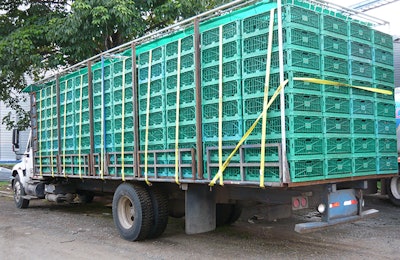
Preventing birds from overheating from harvest to unloading can increase the number of birds that arrive at the processing plant alive and not rejected.
The thermal comfort zone for broilers is between 22 C and 26 C, with a relative humidity of 60%. When temperatures rise above this level, the risk to broilers increases.
Birds release their heat into the environment in a variety of ways, and understanding this can guide any modifications to practices and procedures that are already in place.
Heat loss may be through
- Radiation, which occurs if a bird’s surface temperature is higher than that of its surroundings.
- Conduction, which is heat transfer from surfaces to the environment.
- Convection, which happens when air in direct contact with the chicken is heated, expands and its density lowers.
- Evaporation, which occurs via panting and the respiratory tract, and through the wattles and comb.
Additionally, broilers will exhibit certain behaviors to regulate their temperatures when they are too hot. For example, reducing activity and laying down; raising wings and feathers; eating less; panting; drinking more; and dampening the comb, wattle and feathers.
Harvesting and loading
During harvesting, birds should not be huddled too closely together, as this will increase heat stress. Once birds are inside the cages or containers, their the ability to use their natural cooling behaviors will be significantly reduced.
Once the filled the cages are on the trailer, it may be possible to see a kind of white smoke exiting the top of the trailer. This is due to evaporation.
Without the correct equipment within the trailer to reduce temperatures, the internal microclimate may rise by 8 C above the external temperature while the truck is parked. In this case, large extractor fans can be used to bring temperatures down while the trucks are stationary.
Immediately prior to leaving the farm, some companies douse the birds with water to help them remain cool during the journey to the processing plant. This approach, however, is not always completely successful as the design of trailers does not always allow entry from all sides, meaning that only some birds will be doused.

If the front of the trailer is solid, air will be stopped from entering and cooling the birds. Similarly, insufficient apertures in the back of the trailer will hamper air flow. (Eduardo Cervantes Lopez)
Trailer adjustment
Issues with trailers may include the front of the trailer being closed and the rear not allowing sufficient air to flow out. It may also be the case that the lids or the covers of the containers holding the birds are solid, meaning that that air cannot enter and they may be stacked in such a way as to restrict any air flow.
These issues can be ameliorated by replacing the cover at the front of the trailer with a blind that, during hot months can be opened and, during cold, closed. To the rear, openings could be made larger to facilitate air flow.
Where container lids are concerned, they could be replaced by mesh covers, allowing the air to flow more freely into them, and increasing the comfort levels of birds on their way to the plant.

Solid doors on containers will prevent the free circulation of air. (Eduardo Cervantes Lopez)

Larger openings to the rear will aid air flow. (Eduardo Cervantes Lopez)
To further increase the flow of air into the trailer, a visor can be installed on the cab roof.
If necessary, spaces can be left between each row of containers and air can be channeled between them by temporarily installing vertical dividers.
With a variety of newly directed air flows, broilers will pass the journey to the processing plant more comfortably and fewer will die.
To monitor in real time the various microclimates within the trailer, temperature and relative humidity sensors, such as those used in trailers for transporting frozen and chilled goods, can be installed, and data can be read from a control panel and adjusted by the truck driver.
As the external climate can change at any time, the blinds and visor at the front of the trailer can be adjusted as necessary by the driver from same control panel without the need to stop.

An adjustable visor can adjust air flow. (Eduardo Cervantes Lopez)

Dividers can facilitate the entry of air. (Eduardo Cervantes Lopez)

















